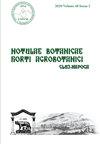Agronomic biofortification with magnesium nanofertilizer and its effect on the nutritional quality of beans
IF 1.3
4区 生物学
Q3 PLANT SCIENCES
引用次数: 0
Abstract
Crop quality has been compromised due to nutrient deficiencies. The macronutrient magnesium (Mg) is essential; however, it has not been considered in agronomic fertilization programs, affecting human health. The objective of the study was to increase the Mg content in the fruits of green beans cv. ‘Strike’ by applying Mg-nanofertilizer, as well as evaluating its effect on growth, performance and nutritional quality, versus magnesium sulfate (MgSO4). The experiment was carried out under shade mesh conditions in Delicias, Chihuahua, Mexico during the period August-October 2022. A completely randomized experimental design was used, with two Mg sources: Mg nanofertilizer (NanoMg) and MgSO4 at doses of 50, 100 and 200 ppm and a control without application, forming seven treatments with six repetitions each. The results indicate that the maximum yield was provided by NanoMg and MgSO4 at 200 ppm, with values greater than 300%. The Mg distribution pattern for the NanoMg treatments presented the following concentration order: root>leaf>stem>fruit; while, for the MgSO4 treatments it was: leaf>root>stem>fruit. The most efficient treatment in increasing the Mg content in the fruit was NanoMg at 200 ppm, which achieved a biofortification of more than 120% with respect to the control. Therefore, when consuming 100 g of green beans cv. ‘Strike’ biofortified by NanoMg, the recommended daily needs of the human being could be satisfied. Finally, it is concluded that nanofertilizers are the best option for a biofortification program since they offer a sustainable alternative by increasing productivity and quality in green bean fruits.纳米镁肥的农艺生物强化及其对豆类营养质量的影响
由于养分缺乏,作物质量受到影响。宏量营养元素镁(Mg)是不可或缺的,但在农艺施肥计划中却没有考虑到这一影响人类健康的元素。本研究的目的是通过施用镁纳米肥料来提高青豆品种'Strike'果实中的镁含量,并评估其与硫酸镁(MgSO4)相比对生长、性能和营养质量的影响。实验于 2022 年 8 月至 10 月期间在墨西哥奇瓦瓦州德利西亚斯的遮阳网条件下进行。实验采用完全随机试验设计,有两种镁源:纳米镁肥(NanoMg)和硫酸镁(MgSO4)的剂量分别为 50、100 和 200 ppm,对照组不施用镁,共七个处理,每个处理重复六次。结果表明,纳米镁和硫酸镁剂量为 200ppm 时产量最高,超过 300%。纳米镁处理的镁分布模式为:根>叶>茎>果实;而硫酸镁处理的分布模式为:叶>根>茎>果实。在增加果实中镁含量方面,最有效的处理是 200 ppm 的纳米镁,与对照相比,生物强化率超过 120%。因此,食用 100 克经纳米镁生物强化的'Strike'绿豆,就能满足人体每天的推荐需求。最后,我们得出结论,纳米肥料是生物强化计划的最佳选择,因为它们能提高青豆果实的产量和质量,是一种可持续的替代品。
本文章由计算机程序翻译,如有差异,请以英文原文为准。
求助全文
约1分钟内获得全文
求助全文
来源期刊

Notulae Botanicae Horti Agrobotanici Cluj-napoca
PLANT SCIENCES-
CiteScore
2.70
自引率
0.00%
发文量
118
审稿时长
3 months
期刊介绍:
Notulae Botanicae Horti Agrobotanici Cluj-Napoca is a peer-reviewed biannual journal aimed at disseminating significant research and original papers, critical reviews and short reviews. The subjects refer on plant biodiversity, genetics and plant breeding, development of new methodologies that can be of interest to a wide audience of plant scientists in all areas of plant biology, agriculture, horticulture and forestry. The journal encourages authors to frame their research questions and discuss their results in terms of the major questions of plant sciences, thereby maximizing the impact and value of their research, and thus in favor of spreading their studies outcome. The papers must be of potential interest to a significant number of scientists and, if specific to a local situation, must be relevant to a wide body of knowledge in life sciences. Articles should make a significant contribution to the advancement of knowledge or toward a better understanding of existing biological and agricultural concepts. An international Editorial Board advises the journal. The total content of the journal may be used for educational, non-profit purposes without regard to copyright. The distribution of the material is encouraged with the condition that the authors and the source (Notulae Botanicae Horti Agrobotanici Cluj-Napoca or JCR abbrev. title Not Bot Horti Agrobo) are mentioned.
 求助内容:
求助内容: 应助结果提醒方式:
应助结果提醒方式:


